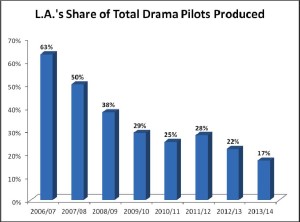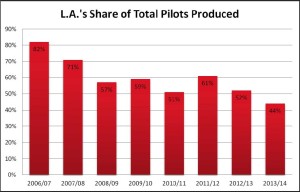![]()
 FilmL.A. released its 2014 Television Pilot Production Report yesterday, raising the alarm about the loss of lucrative TV Drama pilots to New York and other regions with more generous tax incentives. The 2013/2014 development cycle saw New York (with 24 drama projects retained) overtake Los Angeles (with 19 drama projects retained) to become North America’s leading location for one-hour TV pilot production.
FilmL.A. released its 2014 Television Pilot Production Report yesterday, raising the alarm about the loss of lucrative TV Drama pilots to New York and other regions with more generous tax incentives. The 2013/2014 development cycle saw New York (with 24 drama projects retained) overtake Los Angeles (with 19 drama projects retained) to become North America’s leading location for one-hour TV pilot production.
Overall, Los Angeles retained only 90 projects (19 one-hour dramas and 71 half-hour comedies) out of 203 tracked during the 2013/2014 development cycle, yielding a 44 percent pilot production share. Last year, L.A.’s pilot production share was 52 percent, and six years earlier, 82 percent.
Leading competitors – including New York (35 total projects), Vancouver (17 total projects), Atlanta (12 total projects) and Toronto (8 total projects) – continue to gain ground on Los Angeles by attracting pilot producers with generous tax incentive programs.
Most of the pilot projects shot outside California were lucrative one-hour drama series produced for network, cable, or new media distribution. Including “straight-to-series” orders favored by new media content producers like Netflix, these projects cost $6 to $8 million to produce and employ 150-230 people during production. In all, there were 91 drama pilots produced outside Los Angeles this year, whittling L.A.’s share down to just 17 percent of drama projects, another record low.
 “Losing television pilots – and then series – to other North American competitors leads to the destruction of steady, well-paying California jobs,” said FilmL.A. president Paul Audley. “California’s current incentive program makes it hard to attract and retain new pilots and TV series. The data makes plain why an expanded film incentive is needed to bring this part of the industry back.”
“Losing television pilots – and then series – to other North American competitors leads to the destruction of steady, well-paying California jobs,” said FilmL.A. president Paul Audley. “California’s current incentive program makes it hard to attract and retain new pilots and TV series. The data makes plain why an expanded film incentive is needed to bring this part of the industry back.”
Having lost its leadership in drama pilot production, Los Angeles’ status as North America’s premier pilot production location now hinges on its attractiveness to comedy producers. Los Angeles’ share of overall comedy production was 76 percent, down slightly from the 83 percent share it enjoyed last year, but off considerably from the 100 percent share the region captured seven years prior.
The study highlights the effect of incentives on the pilot production market. The California Film & Television Tax Credit – outmatched as it is – has over time helped reverse a tiny amount of runaway production. From 2009-2014, the program has helped relocate seven current series to California from other destinations – a benefit worth thousands of full and part-time jobs and more than $170 million in qualified production spending. None of the series produced in California with the aid of the state’s tax credit have ever left the state in search of a new production location.
The study also examines the impact of new media companies’ efforts at original content production and resulting changes to broadcast and cable business models. This year saw 38 network, cable and new media shows skip traditional pilot testing and instead go “straight-to-series.” More shows went straight to series this development cycle than in the three previous cycles combined. The list of “straight-to- series” shows includes both one-hour dramas (10 broadcast, and 20 between cable and new media) and half-hour comedies (three broadcast, and five between cable and new media).





